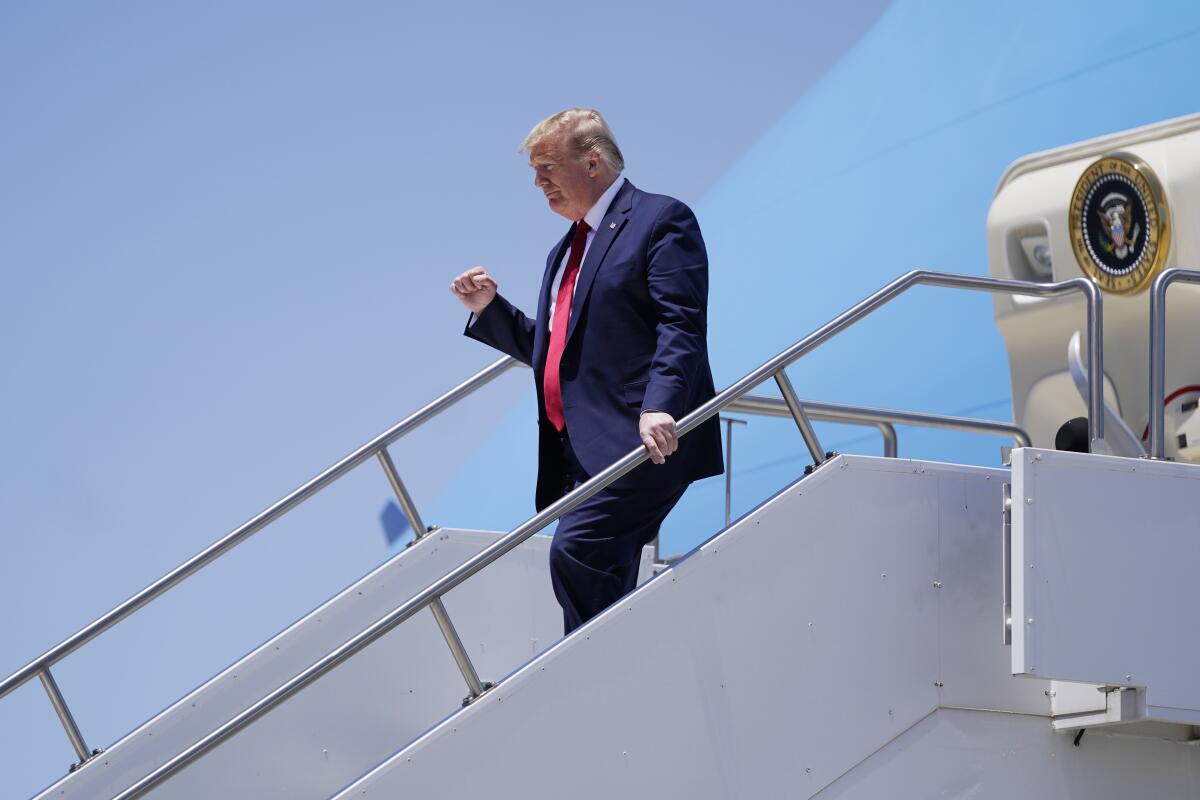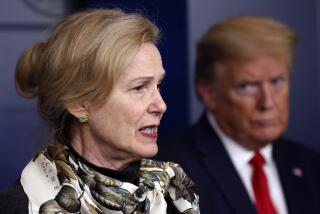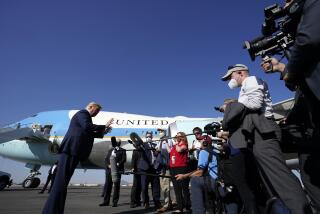White House may close its coronavirus task force this month

- Share via
WASHINGTON — Although the COVID-19 pandemic is far from over, the White House plans to wind down the task force that is guiding the federal government’s response and hand off responsibility to individual agencies, a move aimed at distancing President Trump from potentially unpopular public health decisions as he shifts his focus to the economy and his reelection.
Vice President Mike Pence said Tuesday that the high-profile task force, which has issued social distancing guidelines and directly advised the president since January, could wrap up in the coming weeks and shift its work to the Federal Emergency Management Agency and other agencies.
“I think we’re starting to look at the Memorial Day window, early June window as a time when we could begin to transition back to having our agencies begin to manage — begin to manage our national response in a more traditional manner,” Pence told reporters.
The task force has met less often in recent days as Trump, following a sharp decline in his approval ratings, has stopped holding nightly televised briefings with Pence, public health officials and other members of the group tasked with charting the administration’s course in the coronavirus crisis.
Dr. Anthony Fauci, director of the National Institute of Allergy and Infectious Diseases and a crucial member of the task force, appeared caught off guard by the decision, initially denying reports only to have Pence confirm them a short time later.
Fauci and Dr. Deborah Birx, who heads the White House response team, have sometimes gently corrected Trump’s misguided medical advice, including his dangerous suggestion that injecting household disinfectant could cure COVID-19, and they dissuaded him from lifting stay-at-home guidelines by Easter. Polls show they are far more trusted than the president.
Trump left the Washington area Tuesday for the first time since March to visit a factory in Phoenix that produces protective masks. He donned goggles for the factory tour but did not wear a mask during his visit to a state that this week reported its deadliest day of the pandemic, with 33 deaths on Monday.
Asked about plans to close the White House task force, Trump promised “something in a different form” but suggested its work was complete. He appeared impatient to move on to an economic message, saying the country “is now in the next phase of our battle.”
“We did what was right and now we’re reopening our country,” he said.
The plan to dismantle the group drew immediate concern from some public health officials, who argue that the lack of clear central authority has hindered the nation’s response to a disease that already has killed over 71,000 Americans.
“The concept that we might declare victory prematurely is dangerous from a public health perspective,” said Dr. Chris Beyrer, director of the Johns Hopkins training program in HIV epidemiology and prevention science.
“Too-early lifting of restrictions where community transmission is still underway could lead to an overall prolonging of the U.S. epidemic and to the loss of more American lives — and jobs,” he said.
Jeremy Konyndyk, who led the overseas Ebola response for the Obama administration, noted that infections are rising outside New York, while testing and equipment needs remain unfulfilled. The biggest growth in cases is among those unable to maintain distance — in prisons and at long-term care facilities and high-risk job sites.
Konyndyk likened the White House eagerness to portray an end of the crisis to President George W. Bush’s infamous aircraft carrier appearance beneath a “Mission Accomplished” banner in May 2003, when the war in Iraq was years from completion, a blunder that haunted his presidency.
“Mission abandoned is more like it,” Konyndyk said of the Trump administration. “I’m dumbfounded there’s progress they could cite that would justify anything other than doubling down. The fire is still burning where it’s still finding oxygen and we’re about to give it a bunch more oxygen.”
Robert Hecht, who teaches global health policy and epidemiology at Yale University, said a task force tied to the White House should be kept in place to convey presidential leadership in a “grave crisis.” Disbanding it weakens the ability of Fauci, Birx and other public health officials to align their judgments with economic decisions, he said.
“Perhaps this is why the president and [vice president] want to disband it — to lower the profile and influence of the honest and cautionary messages of Fauci and Birx, so Trump can inject his ‘Happy Time Tunes’ without any dissenting voices,” he said.
Trump has sought in recent weeks to shift responsibility to governors and mayors to begin lifting the lockdown orders that have ground the American economy to a halt and undermined his reelection bid.
With Trump increasingly urging states to reopen, governors and mayors have begun to issue a conflicting patchwork of guidelines, with some states locked down for weeks ahead and others starting to open beaches, businesses and parks.
The president has given mixed signals, attacking Michigan Gov. Gretchen Whitmer, a Democrat, for refusing to ease her state’s stay-at-home order, and then blasting Georgia Gov. Brian Kemp, a Republican, after he became the first to lift restrictions.
Trump also has repeatedly signaled that despite data to the contrary, the worst of the pandemic has passed — and that he deserves the credit.
“People are starting to feel good now,” Trump said in an interview Monday with the New York Post in which he also declared, “the one thing that the pandemic has taught us is that I was right.”
Polling paints a different picture. By 63% to 29%, Americans are more concerned about lifting restrictions too quickly than not quickly enough, according to a Monmouth University survey released Tuesday.
It also showed the president’s approval rating dipping to 43%, with 51% disapproving of his job performance. It found that 55% of Americans think Trump has been “largely inconsistent” in his news briefings.
Lawmakers on Capitol Hill are eager to call Fauci and other members of the task force to testify under oath about the administration’s response. The White House initially said Fauci was too busy to attend a hearing in the Democratic-led House, but Trump offered another reason Tuesday.
“The House is a bunch of Trump haters,” he said.
He added, “They, frankly, want our situation to be unsuccessful, which means death. Which means death. And our situation is going to be very successful.”
Trump said he planned to allow Fauci to testify before a Republican-controlled Senate committee.
The president’s visit to the Honeywell International mask production assembly line in Phoenix had all the hallmarks of a Trump campaign rally. He riffed about his 2016 win in the state, praised a senator running for reelection, and several people, some decked out in Trump 2020 gear, trooped to the stage to offer effusive praise for him.
Perhaps the most discordant note was the familiar rally soundtrack blaring from the speakers — Paul McCartney’s “Live and Let Die.”
More to Read
Get the L.A. Times Politics newsletter
Deeply reported insights into legislation, politics and policy from Sacramento, Washington and beyond. In your inbox three times per week.
You may occasionally receive promotional content from the Los Angeles Times.












